Newest progress reports are at the bottom of the page
I will try and update this page with new photos at least every week. The date at the end of the caption is when the photo was uploaded. The actual progress of the layout is a little ahead of what you see here.
August 2021 -
After almost 4 years I finally uploaded the video taken on the eastbound track starting at Bay Head and ending at the old temporary loop. Bad quality due to an outdated camera system but still interesting, especially if you skip the long helix ride. (8/28/2021)
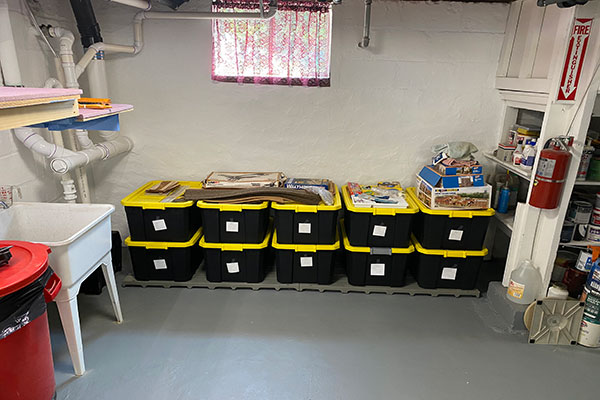
Basement wall repairs are done and everything is back in its place. The bins will move again when helix construction begins. Next up is wiring and turnout control installations on the new upper level, along with turntable and yard controls. (8/28/2021)
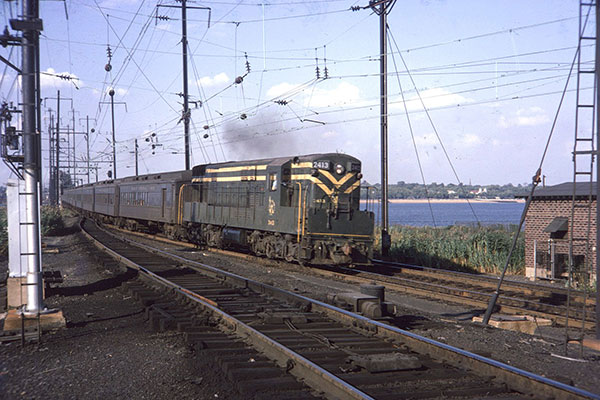
CNJ Trainmaster 2413 heads south off the Raritan River bridge and into South Amboy in 1966. Despite the recent tropical rains here in New Jersey, my basement wall repairs held up perfectly, although we didn't get nearly as much rain as up north. (9/7/2021)
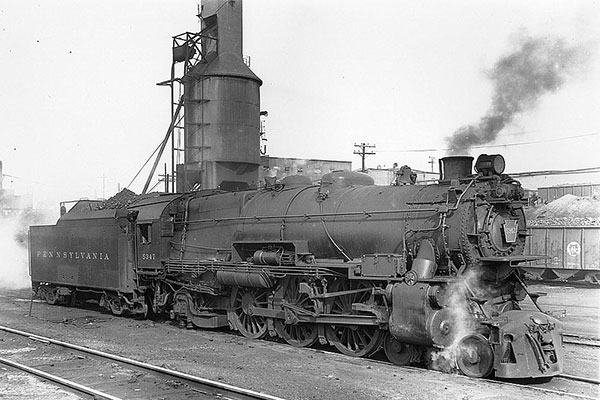
PRR K4s #5347 resides on the engine house track in South Amboy in the mid 1950s. I've started wiring the mainline buss wires but had to order more wire. Also on order are 18 Tortoise switch machines for the red bank area. (9/7/2021)
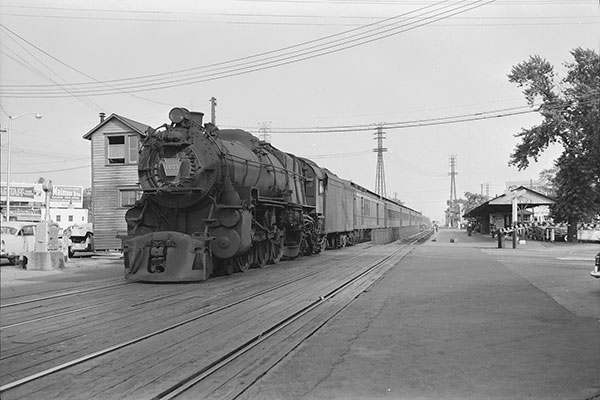
PRR K4s #1453 waits at the Red Bank station for commuters heading to North Jersey and New York City in the mid 1950s. Red Bank station is hidden behind the train but the westbound passenger shed is visible on the right. The wide grade crossing and elevated gate shanty is at Monmouth Street and Bridge Avenue. (9/13/2021)
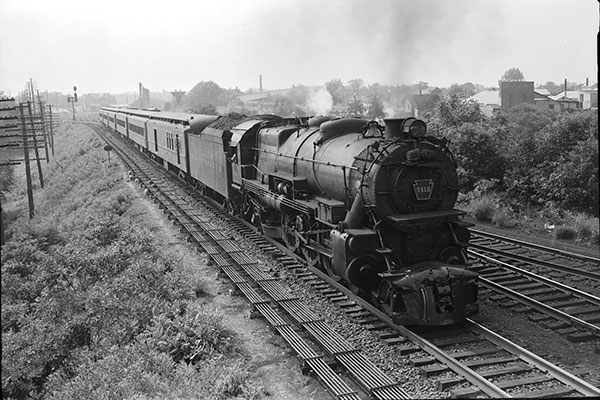
PRR K4s #5412 steams westbound (south) out of the Matawan station in the mid 1950s in this view taken from MR Tower. The diverging track on the right leads to the CNJ Bay Shore line that ran all the way to Highlands in the 50s and was home to the CNJ RDC passenger trains as well as regular freights. (9/13/2021)
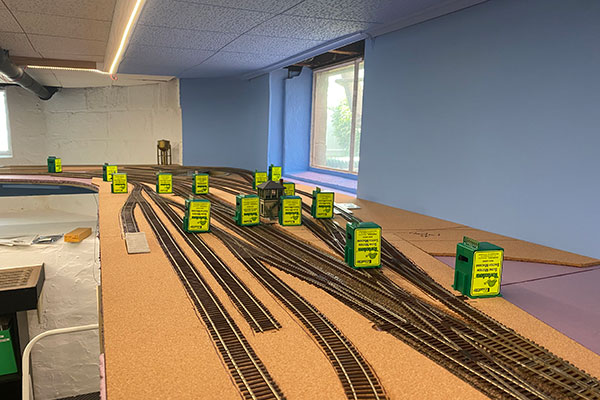
My first order of a dozen Tortoise switch machines arrived and occupy the above turnouts along with two I already had (14 total). Still need a half dozen more to complete Red Bank and also Long Branch, which I decided to automate. (9/22/2021)
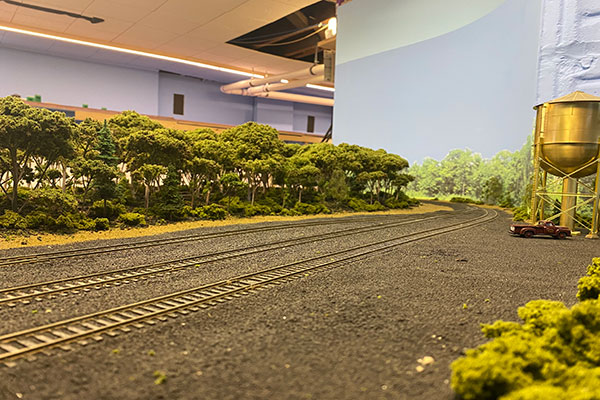
An empty Bay head Jct. loop track and engine tracks await future model railroad activity. Once the upper level is wired and functioning I plan to get some trains running again while I tackle the next helix to the final section of my NY&LB line. (9/22/2021)

The first four Tortoise switch machines have been installed (above) and tied in to the corresponding turnouts. Installing these was a bit tricky, being close to obstructions and beams, as well as connecting to some of the older turnouts. Two of the old ME turnouts needed to have further modifications and repairs to the throw bars after they pretty much fell apart. Plus, one switch machine actuator wire hole needed to be enlarged on the plywood base. Even the best laid out plans can go wrong. The rest will be easier I hope! (9/27/2021)

While the turnouts get motorized, I'm starting to process the plans for the Red Bank Control Panel along the fascia. I have 28 inches to use between the two Tortoises on the edge above. The board with the X will be removed. Unlike the older Bay Head control panel, I plan to build this one streamlined with the latest technology available. The panel will be located above the extreme northern end of the South Amboy Yard (right) and the Raritan River swing bridge (left) to avoid interference with lower level switching. (9/27/2021)
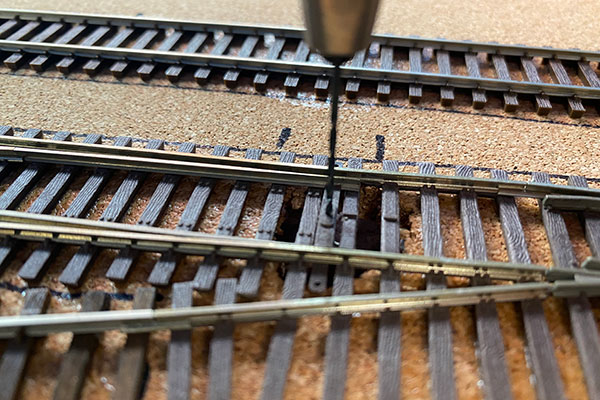
Automation of the turnouts continues. After removing the throw bar tension spring on this ME turnout, I needed to carefully enlarge the throw bar center hole using the correct size drill bit in a pin vise. (10/7/2021)
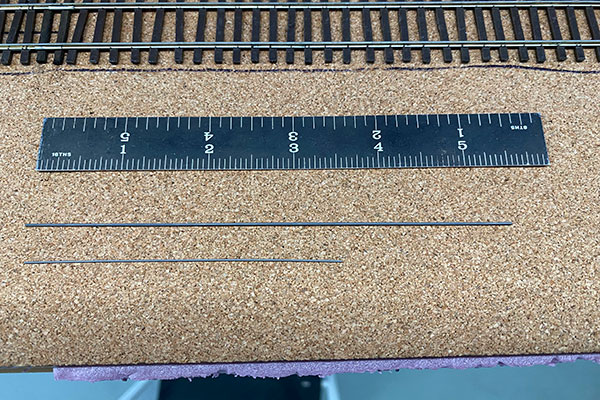
The Tortoise comes with a thin metal wire (bottom) which is used to throw the turnout. Too short and flimsy for my purposes. The heavier replacement wire (top) from Fast Tracks works much better. (10/7/2021)
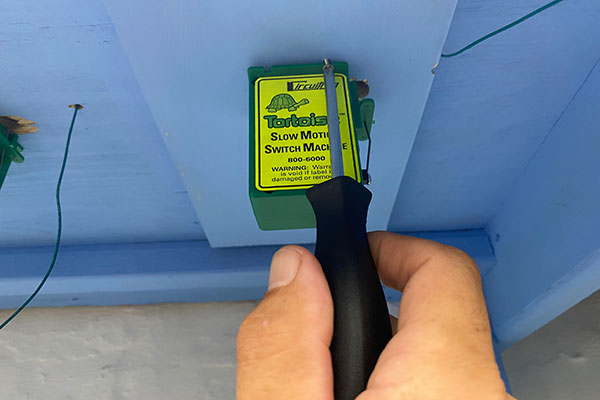
After eyeballing the alignment of the turnout from below looking up through the actuator wire hole, I marked the mounting holes, pre-drilled them, and screwed the Tortoise into place using #4 wood screws. (10/7/2021)

Another angle shows the Tortoise mechanism centered with the wire going up and through the enlarged hole in the turnout throw bar which is also centered. Everything gets re-checked before the remaining mounting screws are added. (10/7/2021)
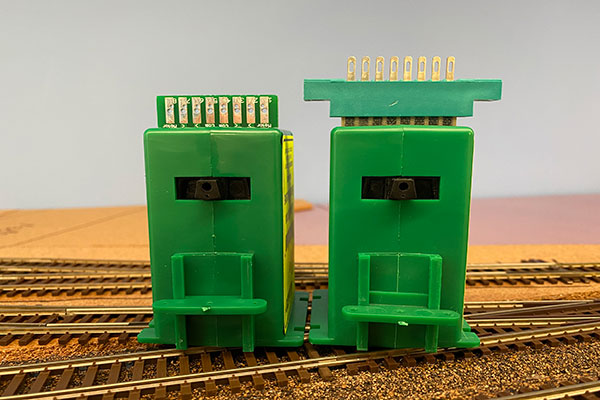
After installing the many Tortoises under the Bay Head Yard, I found it easy to wire them up using a mating connector with solder tabs (right). These connectors can be purchased from any electronics supplier or can also be found on the Internet. (10/7/2021)
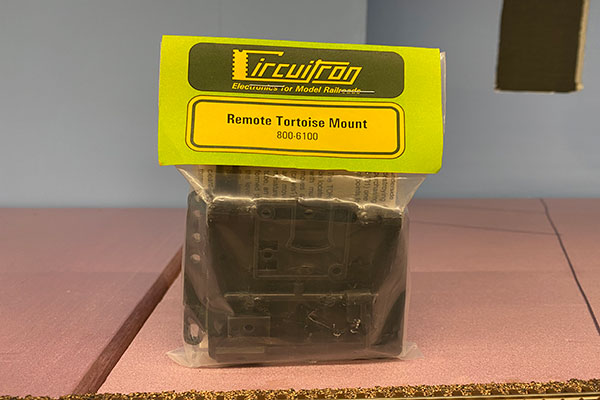
Years ago I purchased a half dozen Remote Tortoise Mount kits (above) but have not yet found the need to use them. They might come in handy when I reach the South Amboy section with the complex track work planned there. (10/7/2021)
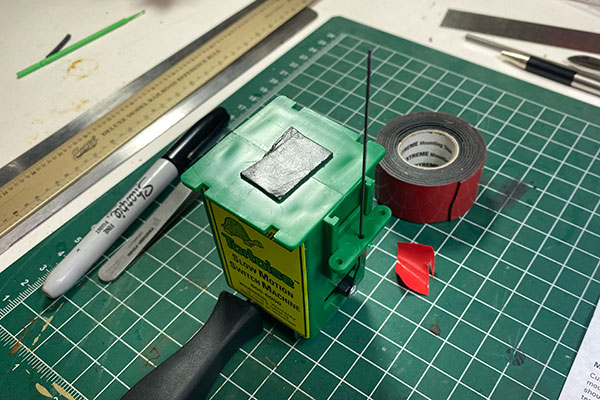
One thing I left out that makes installing these Tortoises much easier is the use of a small piece of thin double-sided tape. After lining up the machine and the actuator wire with the center hole on the turnout throw bar, I just press the machine into place. The tape holds it in position while I fasten it securely with screws. The tape alone won't cut it so the screws are necessary. (10/10/2021)
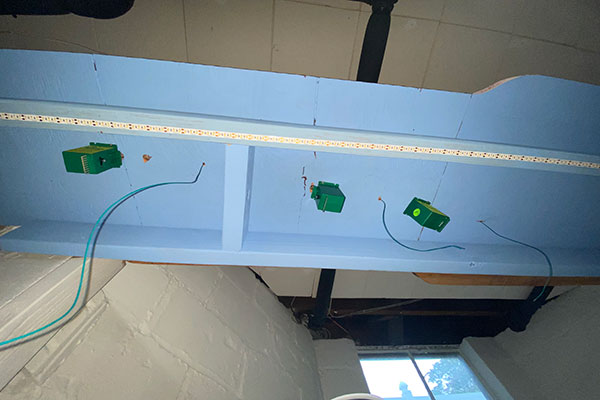
After much thought, I decided to automate the Long Branch yard with Tortoises as well. Having manual turnout throws here would interfere with the nearby Bay Head loop area, so now these three turnouts will be operated by a small panel on the fascia with switches and indicator lights. The view above is looking up from underneath at Long Branch. (10/10/2021)

Fifteen Tortoises have now been installed in the Red Bank-Long Branch section of the layout with six to go when they arrive. While prepping the remaining turnouts, this old modified ME turnout in the Red Bank yard blew up while I was drilling out the throw bar. It was a lost cause so out came the putty knife and out came the turnout. (10/10/2021)
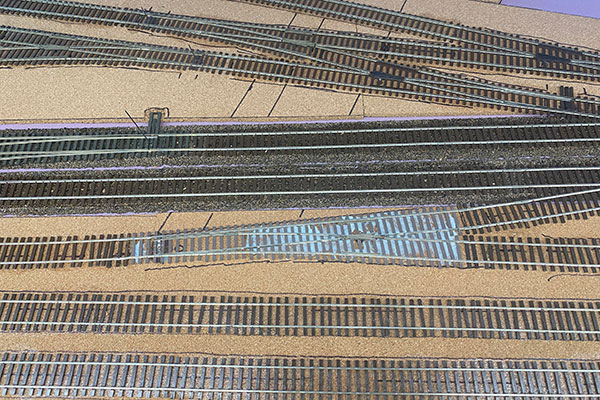
I dug out another old code 70 ME non-DCC turnout from my dwindling stock and proceeded to modify it for DCC as was previously shown on Page 8. Practice makes perfect as it went without a hitch and resulted in a much better replacement to what was there. A little caulk and some sliding of six rail joiners and it's good to go! (10/10/2021)

Got a new drone and went down Bay Avenue to shoot some video above the forest in the Bay Head loop. Wow! - no trains on the service tracks? ... and the old water tank is back and painted gold??? This new drone is pretty amazing! (10/11/2021)
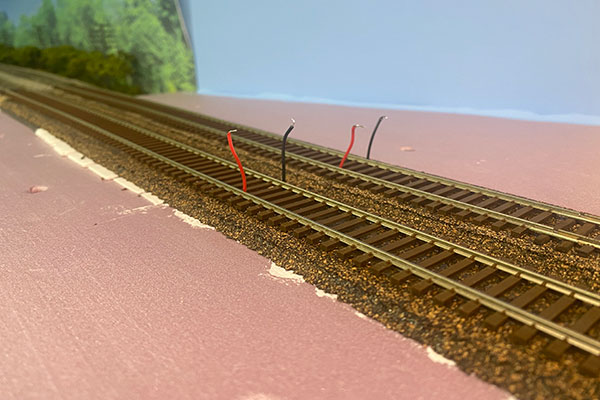
Back on the layout, the first track feeder wires are ready to be soldered to the tracks in Long Branch. Following the advice of some other noted modelers, I always solder the feeders on the side of the rails away from the point of view. (10/11/2021)
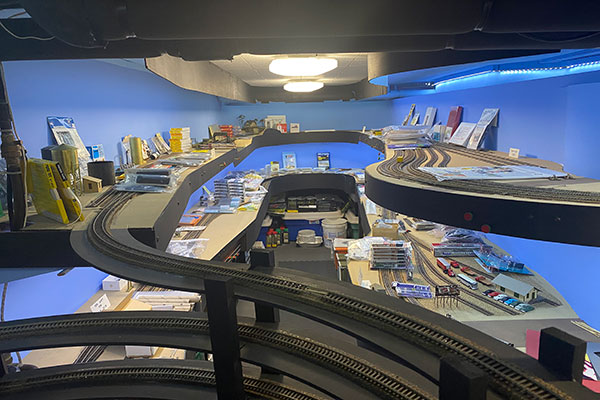
Another rainy day and I decided to go through my modeling stock and refresh what I have. This view shows about half of the whole mess. After hours of sorting and rediscovering what I had squirreled away, the above mess disappeared into organized bins. (10/11/2021)
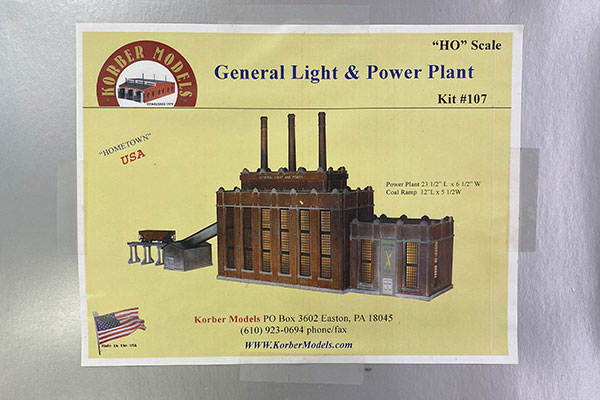
While sorting through everything, I took photos of all the kits waiting to be built so I don't go and buy something I already have. An example is the above Korber Power Plant kit planned for replicating a former landmark power plant in South Amboy. (10/11/2021)
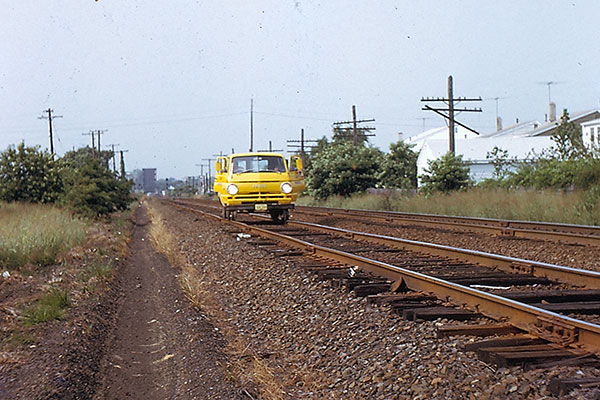
A High-rail inspection van poses on the NY&LB in Point Pleasant Beach circa 1970. The Manasquan River draw bridge is in the distance. Wiring on the layout continues while awaiting frog juicers for the turnouts. (10/29/2021)
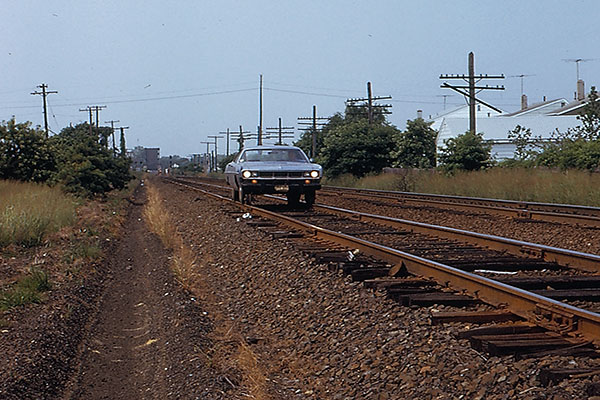
Same day, different High-rail vehicle. Note the clean ditch along the tracks. At this point in time track maintenance was still a priority on the NY&LB but slowly fading. I hope to soon add more data to the Locomotive and Rolling Stock pages. (10/29/2021)
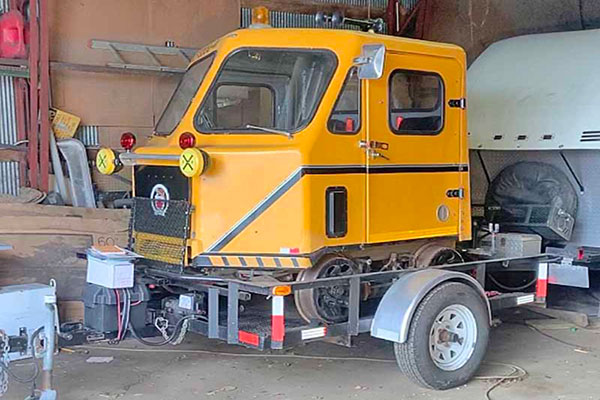
I took a break from the layout the past month to pursue a long simmering desire - to own and operate a vintage railroad inspection car, commonly known as a "speeder" or "railcar". After joining NARCOA earlier this year, I started searching for a two-person car for sale and came across this Woodings CBI car located in Indiana. The car and custom trailer offer was too good to resist so a trip to the Midwest was planned and executed. (11/24/2021)
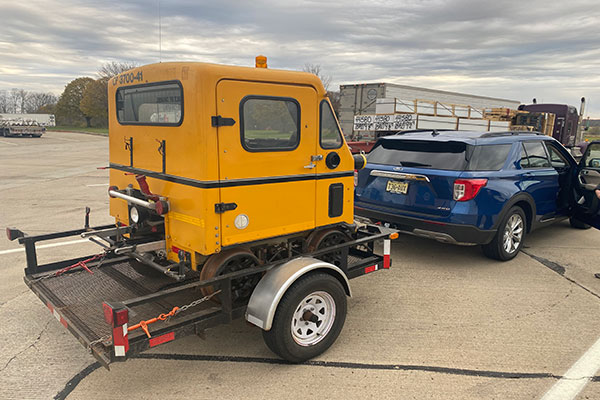
After picking up the car, I took this photo at a rest stop, followed by truckers walking over asking what the strange looking vehicle was that I was towing. It was a long drive back to New Jersey but I was thrilled to finally own a rail speeder. I have added a page to this web site documenting the progress of my new 1:1 scale hobby HERE. Progress on the layout will now resume with updates forthcoming. (11/24/2021)

Busy, busy, busy! I haven't managed to make time for the basement yet but I did find a small bin tucked away in the garage that had seven freight cars in it. Don't know why they were separated from the rest of the rolling stock, but they will be added to the Rolling Stock page shortly. In front of the cars are the Frog Juicers awaiting installation. (12/5/2021)

Just about every view of my basement has been shown on these web pages, but here's a new one. These are the stairs down to the layout. The entry from my driveway is on the left while the stairs up to the first floor are on the right. The helix is just visible at center. With the railcar tucked away for the winter, my focus is back on the layout. (12/5/2021)

Layout construction progressed slowly during the past month. Looking back, I guess I needed to take a break, walk away for a while, whatever it was. It didn't help that the basement was getting dank and smelled like wet leaves for some reason. I spent more time trying to find out why, than doing actual layout work. Above, 12 gauge bus wires are unwound from their spools and waiting to be installed. (1/2/2022)
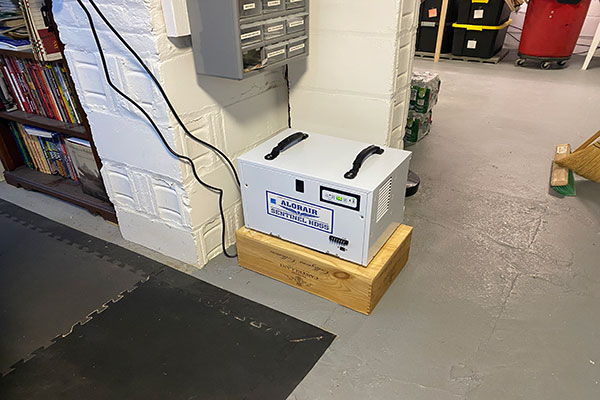
With my old dehumidifier on the fritz since last summer and a dank odor permeating the basement, I first bought a new, industrial-grade dehumidifier, shown above. I finally found the odor source - a bag of sedum blooms I picked last fall, and instead of letting them dry out in the garage, I tied up the bag and threw it in the basement. Big mistake!!! That bag quickly went into the trash. Big lesson learned! (1/2/2022)
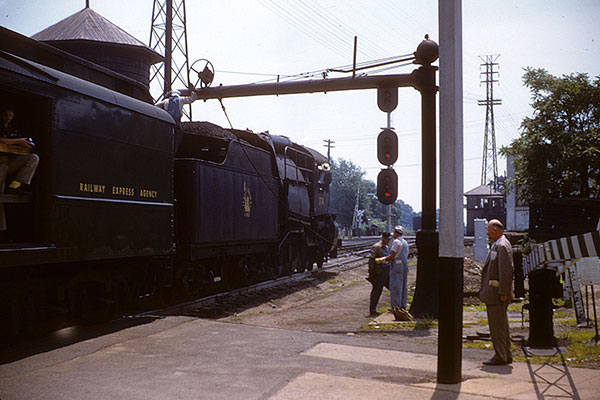
CNJ Camelback #774 takes on water in Red Bank on its commemorative run on the NY&LB in July 1954. The grade crossing is Oakland Street. The entrance to the CNJ Southern Line is in the background with the water tank showing above the baggage car. (1/7/2022)
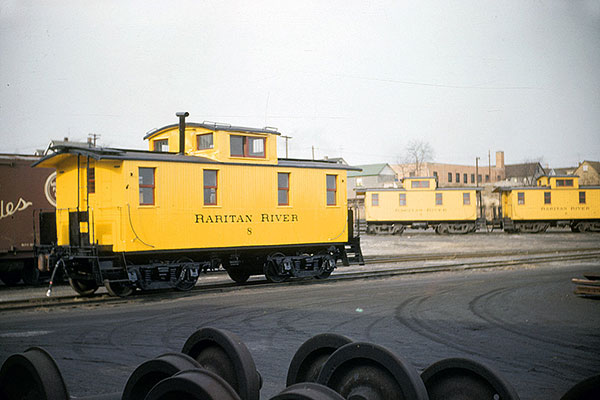
Raritan River Railroad caboose #8 is resting with it's brothers in South Amboy in 1954. I plan to model the interchange of the RRRR with the NY&LB in South Amboy when I get to the future lower level. (1/7/2022)

Here is the entire NY&LB Red Bank interchange with the CNJ's Southern Line and yard. The tape on the tracks are where feeders are installed and awaiting soldering. There's still quite a few more to go. Soldering feeders and running buss wiring has already been covered on this web site, but I'll add anything new I discover in that area. (1/20/2022)
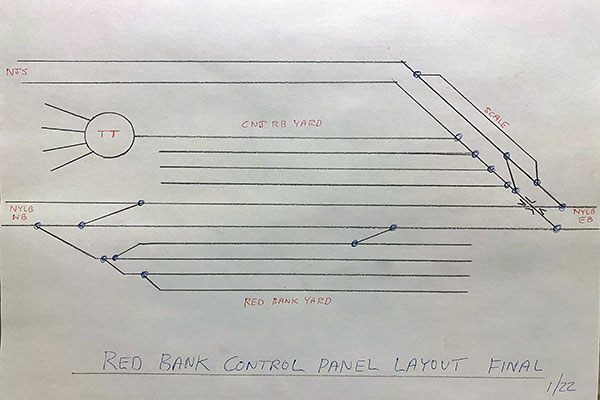
In order to make this section of the layout functional, work on the RB Control Panel is under way. Above is the final schematic to be used on the actual panel. This panel will be 28 inches long while the height is yet to be determined. There's 18 turnouts to be controlled as well as the turntable. Eight of the turnouts will be interlocked. (1/20/2022)
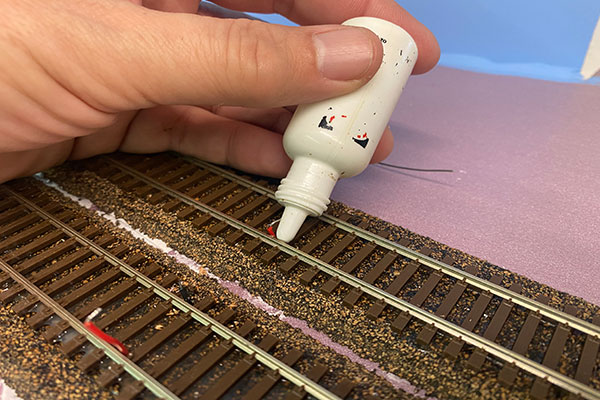
Since wiring is the main work on the layout right now, here's a view of applying flux to the rails while installing feeder wires between the rails and DCC buss. A decent amount of flux is desired here so no micro-brush applicators at this stage. (1/30/2022)
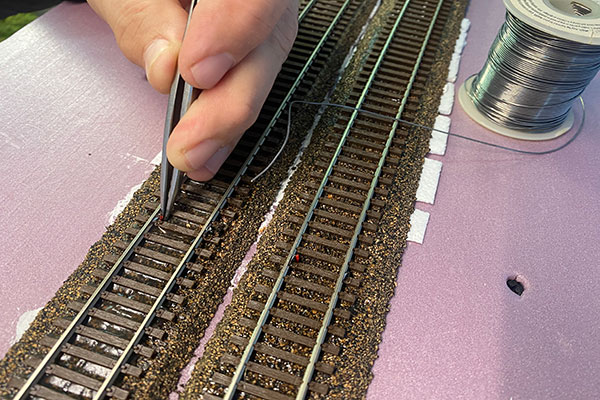
I hold the wire next to the rail and solder into place, holding the wire with stainless steel tweezers until the solder cools. I also install the feeders on the sides of the rails away from the front of the layout so they aren't so obvious. (1/30/2022)

The DCC power buss is installed under the layout to the first of two lift-out sections (top). Here I plan to install connectors on the two wires. (1/30/2022)
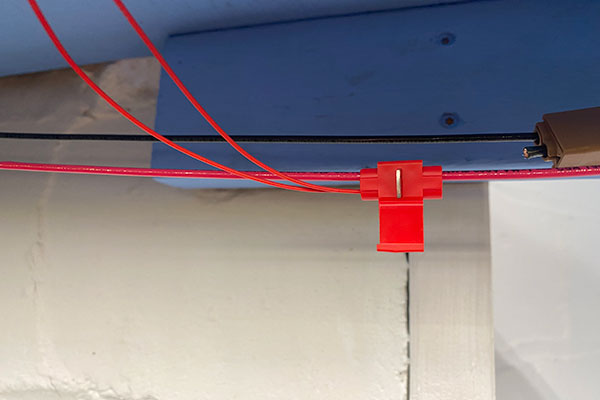
A suitcase wire connector is placed on the red buss wire while two feeder wires from the tracks are inserted into one side of the connector. (1/30/2022)

Holding the two wires in place and fully inserted, the metal knife on the plug gets crimped, piercing all three wires and making an electrical connection. (1/30/2022)
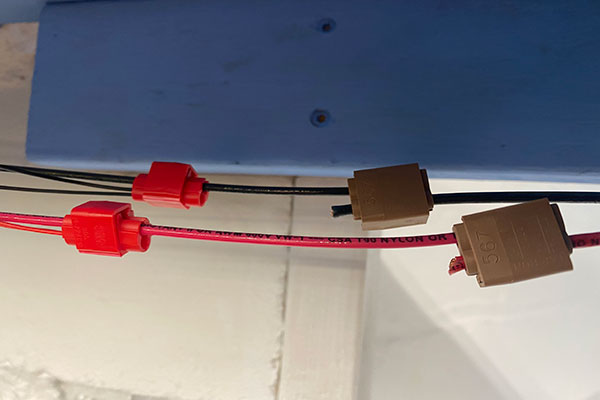
After the crimp, the cover closes over the connector like a suitcase. Easy peasy. The larger brown connectors I used as a splice for the buss wires. (1/30/2022)
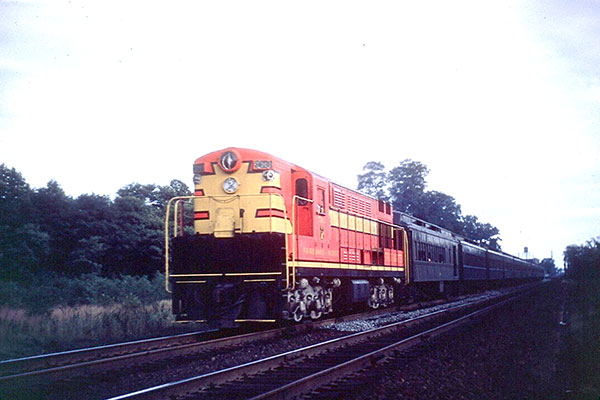
A Fairbanks-Morse Trainmaster Demonstration diesel #TM-1 heads north out of Red Bank hauling a CNJ commuter train in 1953. F-M had four of these units for railroads to try out around the country. The CNJ was impressed and was a big customer. (2/15/2022)
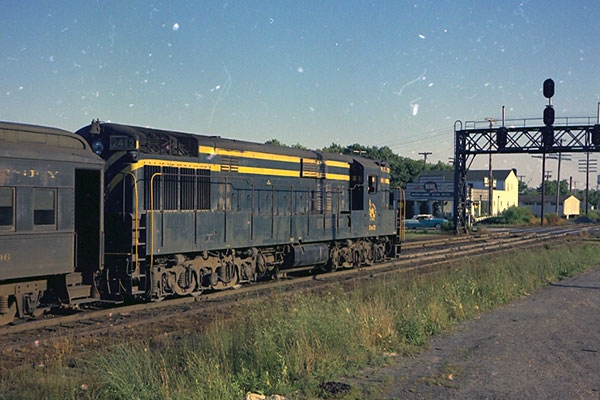
By 1960, Trainmasters were handling much of the CNJ commuter runs along with GP-7s and occasionally the smaller Baby Trainmasters. These engines were moved around over the CNJ system and were already looking tired by now. (2/15/2022)
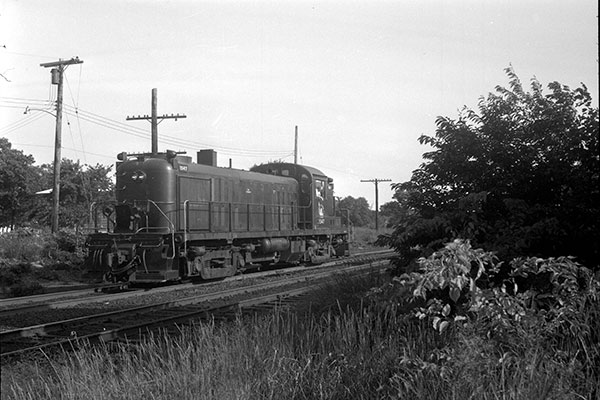
While wiring on the layout continues, here's a look back at the NY&LB in the summer of 1965 in Point Pleasant Beach. Above, CNJ RS-3 #1547 (blt. 1950), switches cars at two sidings just north of the station in August. (2/22/2022)
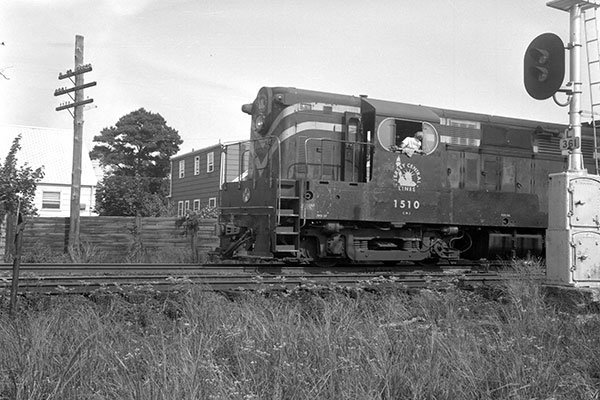
Although they were starting to be phased out by the CNJ at this point, Fairbanks-Morse Baby Trainmaster #1510 has freight duty on the Bradley Beach Turner in July. There was a crossover track at these sidings back then. (2/22/2022)
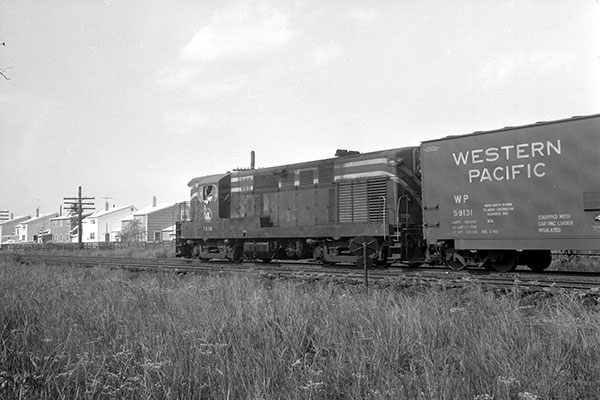
CNJ #1510 waits to cross over to the westbound track to service the Point Distributors beer siding. This same siding previously served Rheingold beer and the coal pockets at Point Bay Fuel. (2/22/2022)
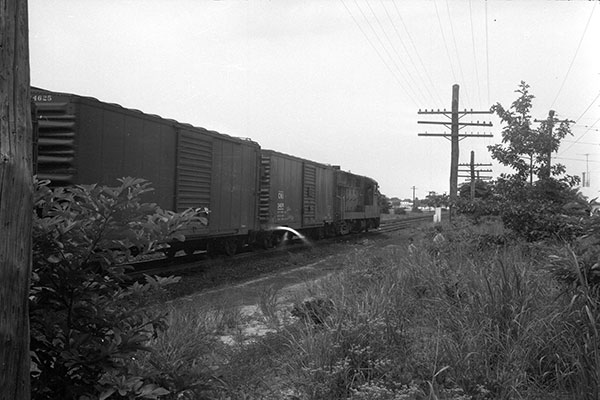
A different day and another H15-44 has the honors. This time it's the northbound track siding which served the Van Note Lumber Company and the former freight house. The freight trains always drew an audience of kids, including me. (2/22/2022)
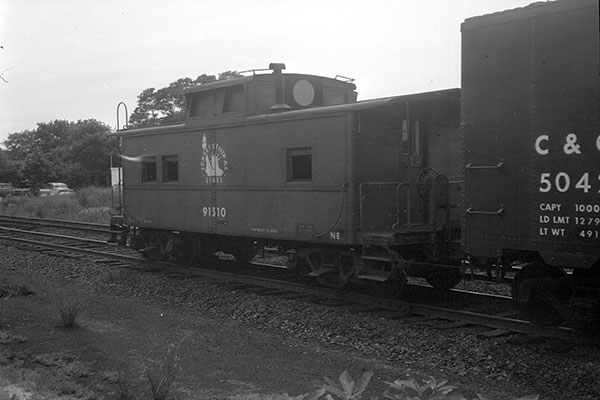
On this particular July day in 1965, CNJ steel NE caboose 91510 trails the Turner Freight run down to Bay Head and back up the NY&LB. (2/22/2022)
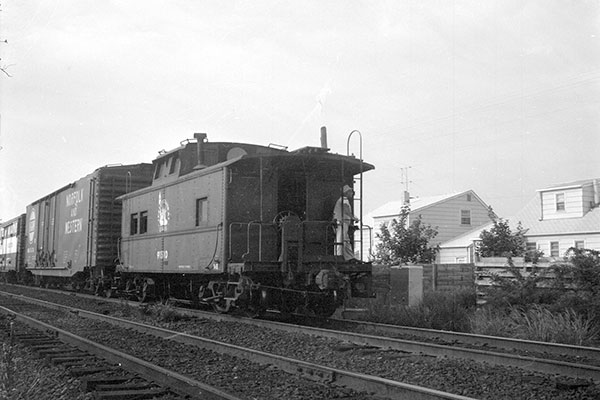
With the switching of the two sidings completed, the Bradley Turner heads north (RR east) out of Point Pleasant and to the next assignment. (2/22/2022)
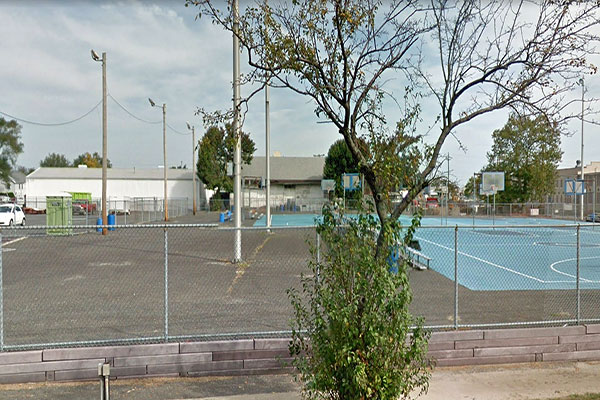
Wiring continues while I'm preparing for construction of the Red Bank control panel. In the meantime, freight stations populated the NY&LB in many towns from South Amboy to Point Pleasant. Most were built following the standard CNJ construction plans. The freight station in Belmar originally stood on the west side of the tracks south of 10th Avenue. before it was moved in the early 1960s as part of an agreement made between the railroad and the Borough. (3/6/2022)
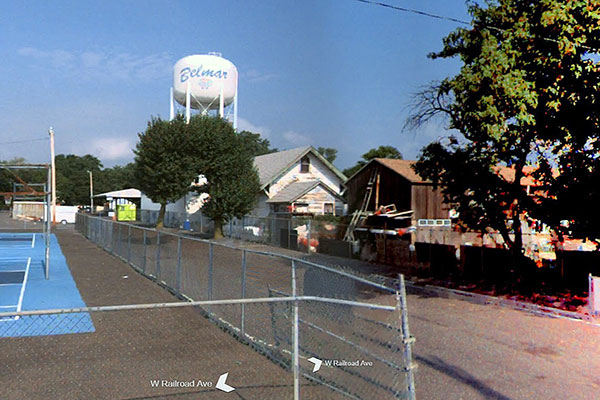
While no longer needed by the NY&LB, the freight station building was removed for parking and was relocated 3 blocks south to the Belmar public works property (above center in 2009 and center left photo 2013). It's still standing pretty much intact. The Coast Gas Company Natural gas holding tanks occupied the parking area to the left in both photos until the mid 1970s along with a coal gasification plant closer to the tracks where the basketball courts are now. (3/6/2022)
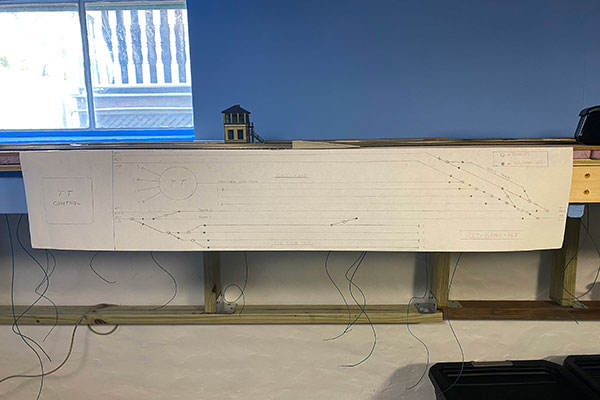
I have completed a full-scale template for the Red Bank Control Panel and positioned it on the layout (above). It's 7 inches high and 34 inches long. I'm considering chopping down the length of the panel by a third before construction. (3/13/2022)

On the far left of the panel is a spot for the turntable controller, show above. This unit came with the Walthers turntable and I'm going to give it a try. Turntable to track alignment indication is another hurdle to tackle. (3/13/2022)

A closer view of the left half of the panel. After a lot of consideration, I'm going with the same basic construction as the Bay Head Yard panel, but a little more refined. Have a load of switches and led's on hand from that project, so..... (3/13/2022)

The right half of the panel. Turnouts will still be operated with toggle switches (white circles) while the track indicators will be bi-color red and green led's (black circles). I'm now debating whether to have the panel background black or white. (3/13/2022)
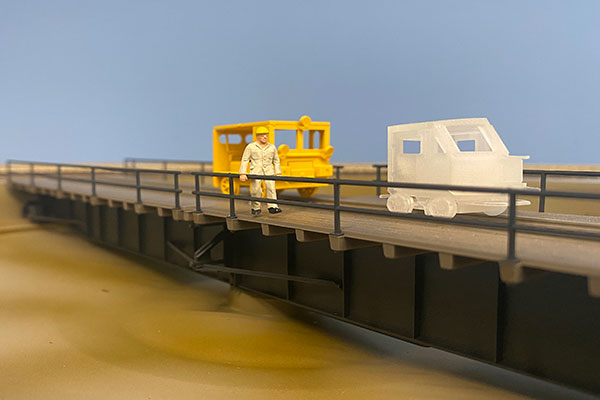
Soldered more track power feeder wires today. Looking forward to powering up the tracks soon! Above, two rail speeders sit on the Red Bank TT. A Fairmont section car and a Woodings CBI in front, not yet painted to match my car. (3/17/2022)
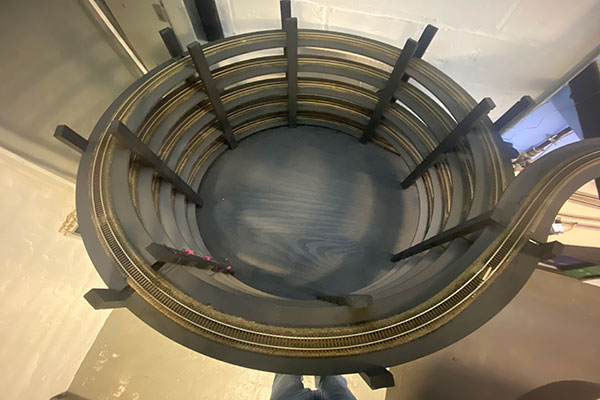
Here is an interesting shot of my first helix from above - a love-hate, but necessary, part of the layout. The upcoming helix on the other side of the basement is going to look quite different, and hopefully, be my friend. (3/17/2022)
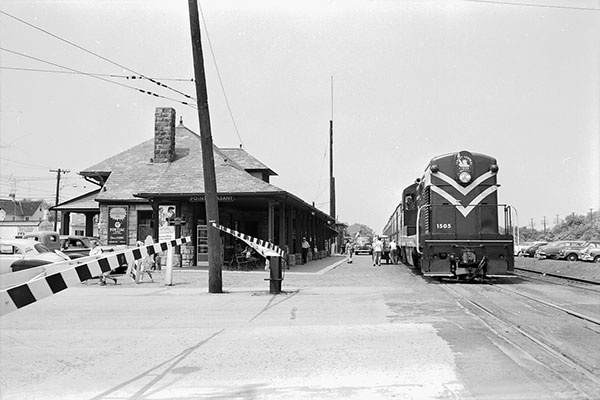
Just back from a two week vacation and will be resuming layout construction. In the meantime, CNJ H15-44 #1505 is stopped at the Point Pleasant Beach station in the mid 1950s on its way to Bay Head Junction. (4/4/2022)
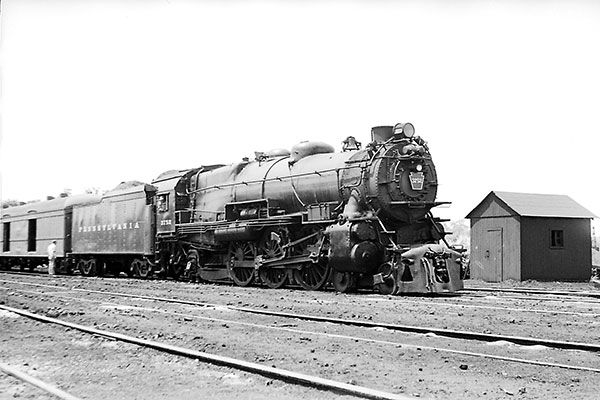
Also in the mid 50s, PRR k4s Pacific #3752 waits at the Bay Head loop for its northward journey to South Amboy or Jersey City. The small shanty to the right has become iconic, appearing in numerous 1950s photos at the "loop". (4/4/2022)
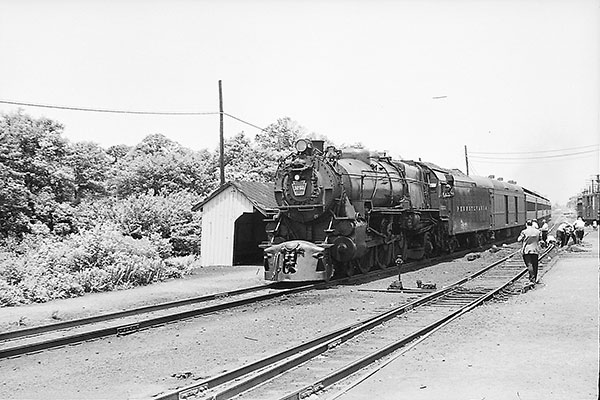
PRR K4s #3752 (with the extra headlight above the number plate) stops at Bay Head in the mid 1950s. The station is off the photo to the right and the passenger shelter is center. On the right, work gangs appear to be tending to the BH cross-over while on the extreme right sits a CNJ freight on the lead track to Ferry Lumber. (4/14/2022)
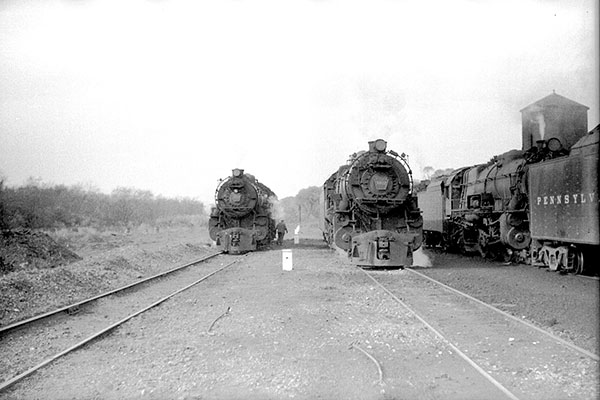
At least four PRR Pacifics idle on the Bay Head loop engine servicing tracks in the mid 1950s. On the layout, I'm finishing up soldering a boat-load of track power feeder wires. The next post will show that progress. During lulls or boring periods in layout construction, I hope these prototype photos from my archives fill the construction void. (4/14/2022)

Since I have two sections of the new upper level that need to be removable to gain access to two crawl spaces, I need to improvise with the wiring. Above, the track buss wires get crimped into connector spades at the edge of the lift-out. (4/28/2022)
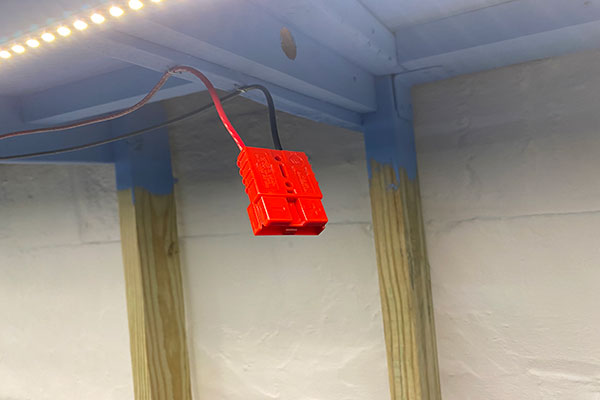
One half of the connector is installed. Another connector is on the far end of the second lift-out off to the right. These connectors are heavy duty and should serve its purpose. I'll also need to put connectors on the future accessory 12 volt wires as well. (4/28/2022)
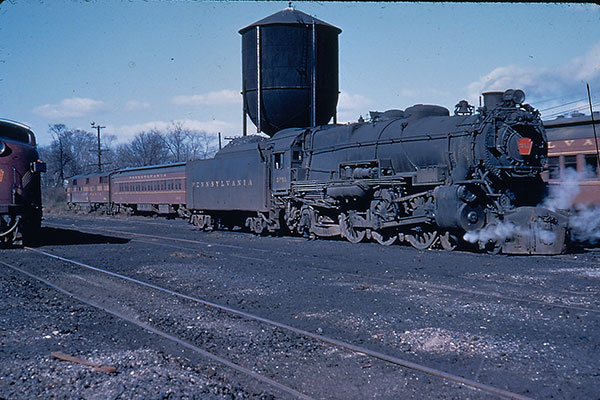
PRR K4s 3751 waits for its next commuter run out of Bay Head in the mid 1950s. What a great place Bay Head was then - on par with South Amboy. Once again, I've been delayed on the layout with spring household chores. (5/24/2022)
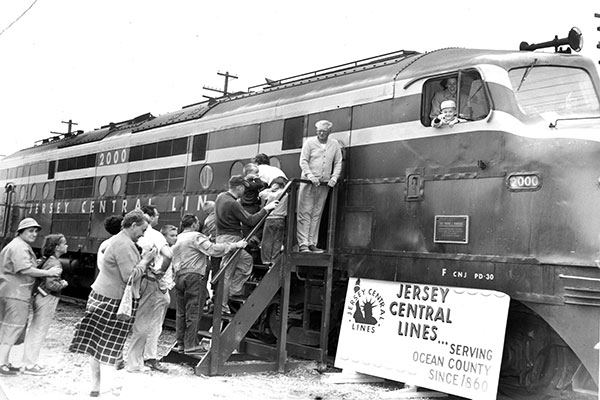
In August 1955, the CNJ parked Baldwin double-ender #2000 on the freight house siding in Pt. Pleasant Beach for on-board tours of the marvel diesel. The children are holding their ears, so my guess is the engine was powered. Great!!! (5/24/2022)
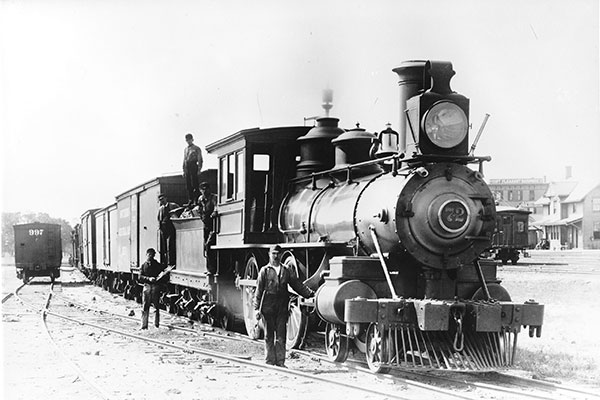
More history .... here is CNJ #72 parked in the Point Pleasant yard in the mid 1890s. The view is south and this entire area is now a municipal parking lot for the present Point Pleasant Beach station on the NJCL. The original NY&LB station is on the right. The #72 was named "Pequot" and built by the Taunton Locomotive Works, Massachusetts in 1865, and went into service on the CNJ in February 1866, some 30 years prior to this photo. (5/26/2022)

In the northeast part of the Point Pleasant yard stood the engine house and turntable. This is the second engine house, shown around 1908. In another ten years the Bay Head loop would come into existence and the Point Pleasant yard would be closed by 1930. On the right is another CNJ Locomotive, #60, which appears to be another Taunton Works creation, but no further information on this loco has yet to be located. (5/26/2022)

On the future lower level last leg of my layout will be the South Amboy engine facility. PRR K4s engines are numerous at this facility in 1950. The coaling tower and power facility stack are in the background as is the engine house. (6/6/2022)
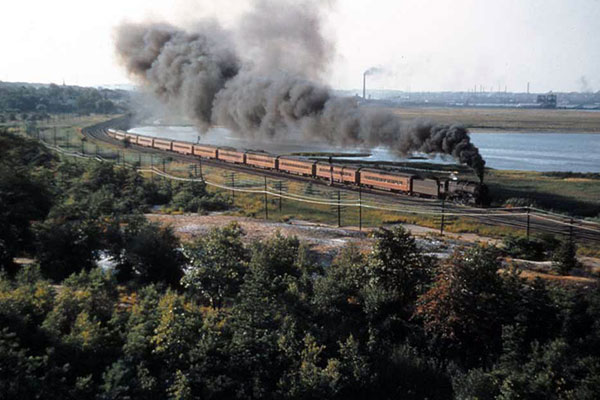
A PRR commuter run heads RR west out of South Amboy along the Raritan Bay in the mid 1950s. I'm planning to model as much of this as possible coming off the helix to the lower level. This is classic railroading at its finest! (6/6/2022)
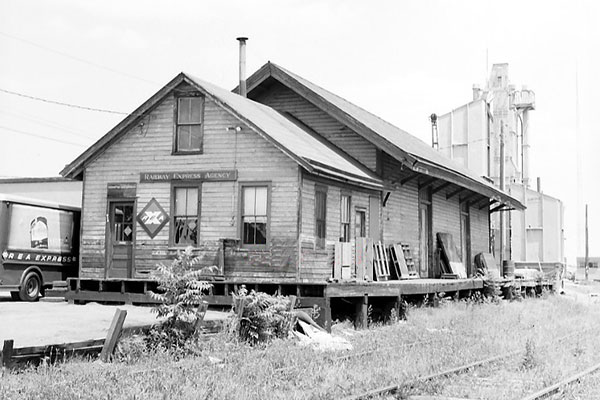
Lately I've been giving thought to the upcoming helix and how I'm going to tackle the project and not make the mistakes I made with the first helix. First and foremost it will be built in-house and be an oval shape. I'm trying very hard to include a portion of Matawan inside the top of the helix with connections to the Seashore and Freehold branches. (6/27/2022)
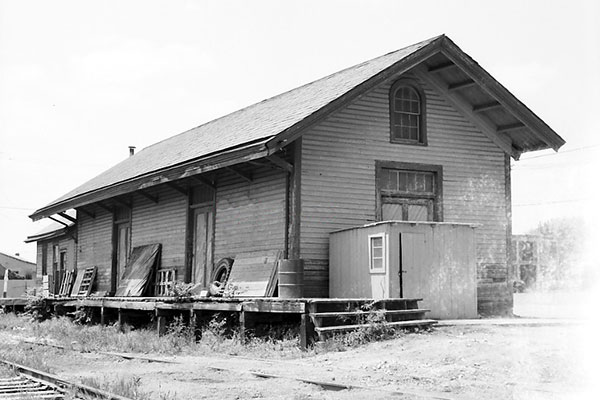
Above and on the left is the Matawan freight station in the 1960s. Typical CNJ construction and very similar to others on the NY&LB. The REA Express office occupied an extension off one end of the structure (left). These will be fairly easy to build when I get to that phase of construction, which is slowly progressing. (6/27/2022)
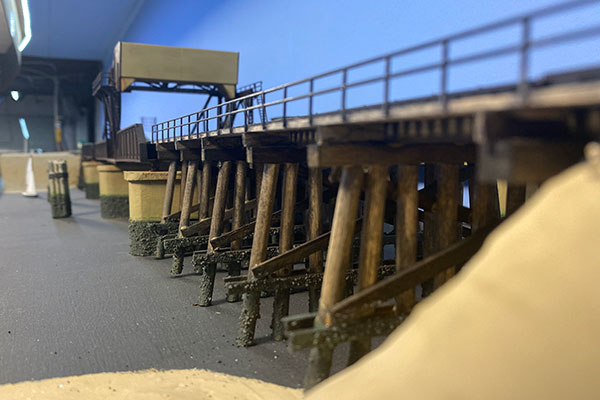
Recently I've been back at work on the layout after a bit of a hiatus. I've resumed the installation of track feeder wires on the new extension through Red Bank. Not really work worthy of photos so above is a shot of the Shark River bridge at Belmar. (7/24/2022)
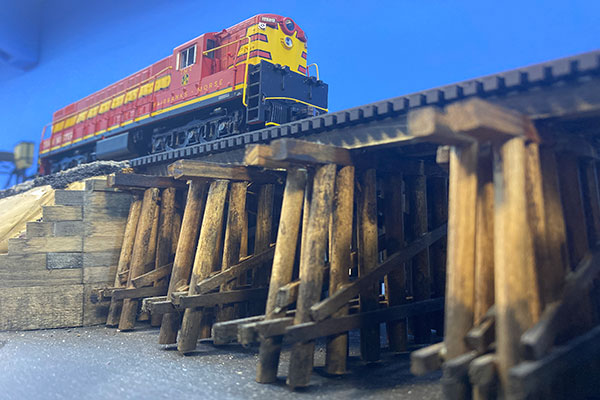
Another shot of the other bridge so far on the layout - Manasquan River with a Trainmaster Demonstrator passing over. I'm anxious to get moving on the layout again so watch for more frequent updates as the wiring is completed. (7/24/2022)
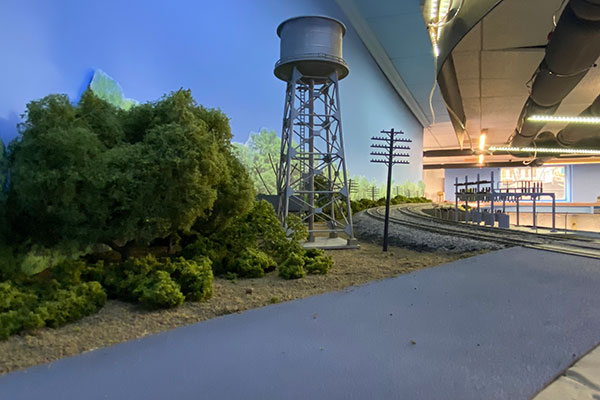
The modeled Grassmere Avenue in Allenhurst. I'm presently working on soldering over 100 track power connections on the new section. Tedious work but it's well on the way to completion. Then the entire layout will need to be inspected before the DCC switch is thrown and the first powered train rolls into Long Branch and Red Bank. (7/26/2022)
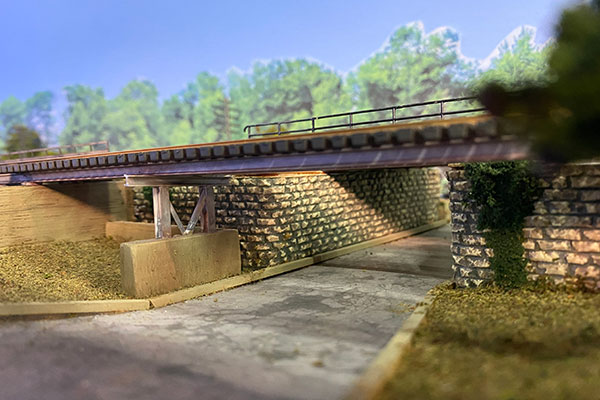
The modeled Cedar Avenue in Allenhurst. After the present track is powered and tested, I'm moving forward with the next helix. This will be oval-shaped with minimum 24 inch track radius and double tracked. Matawan will occupy the top level and it will include connections with the Freehold and Highlands branches, both leading into staging tracks. (7/26/2022)
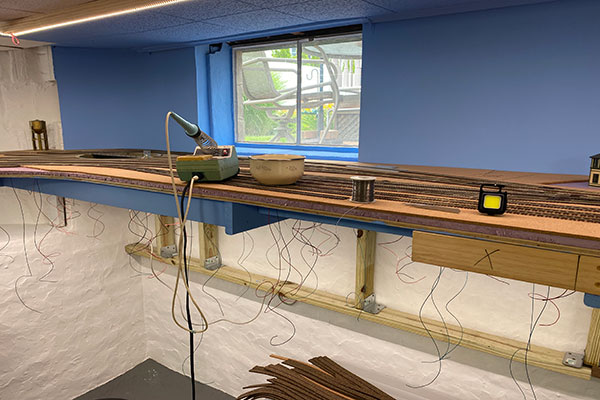
My trusty Weller soldering station, in my shop for over 35 years, got a good workout while soldering the numerous track feeder wires on the new section. (7/28/2022)
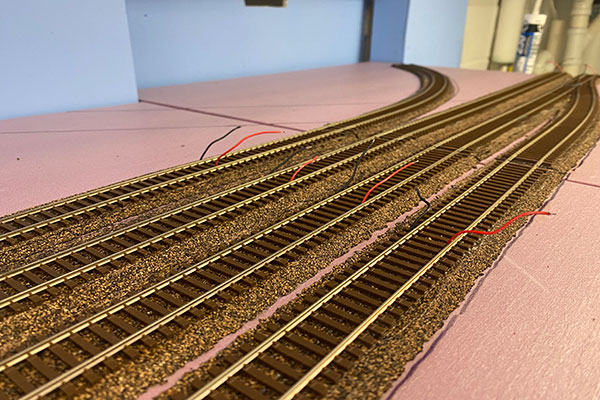
The last remaining track power feeder wires are awaiting the solder iron. The next step will be to connect all of 100+ of these wires to the power bus wire pair. (7/28/2022)
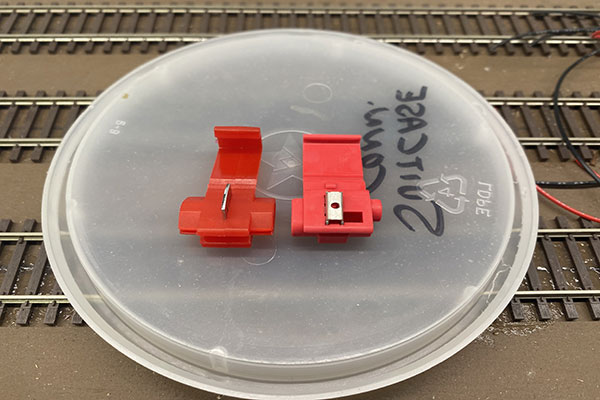
Above are two suitcase wire connectors. The one on the right is a Scotchlok connector that I have used previously on the layout so far. The one on the left is a cheap knock-off. Lesson learned - I used the cheap connectors and, quite frankly, you get what you pay for. Another lesson learned - check the track for shorts before wiring it to the power bus wires. I have a short and no way to troubleshoot it until I disconnect the feeder wires. (8/1/2022)
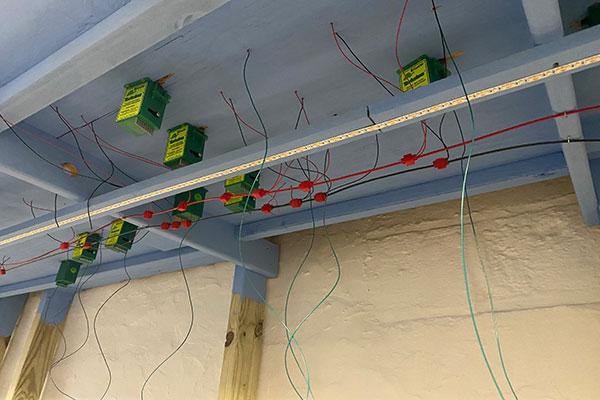
So now I will be removing all of the cheap connectors I used (some shown above) so I can troubleshoot the short in the tracks. I went over everything with an eye loup but couldn't locate the trouble so off come the connectors. Once I fix the short the feeders will be attached using the good connectors which I have ordered. Needless to say I'm kicking myself for cutting corners by not checking the track first and by using cheap connectors. (8/1/2022)
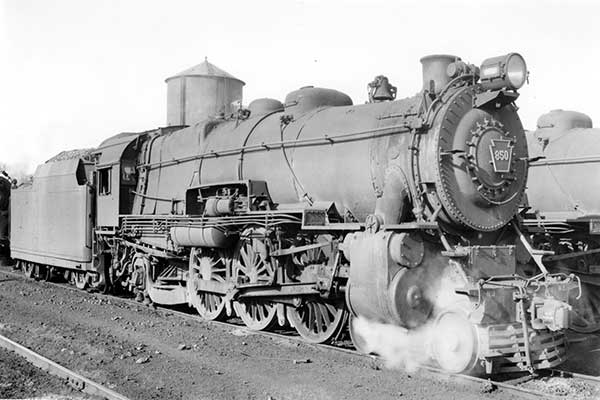
Well ... It's been a long six months since my last post here. After the debacle with all of the cheap wire connectors, I promptly faced using a good part of the basement for temporary storage for a family member. So, I decided to take a break from the layout and re-group. Anyway, above is PRR #850 at Bay Head yard in the 1940s. (2/26/2023)
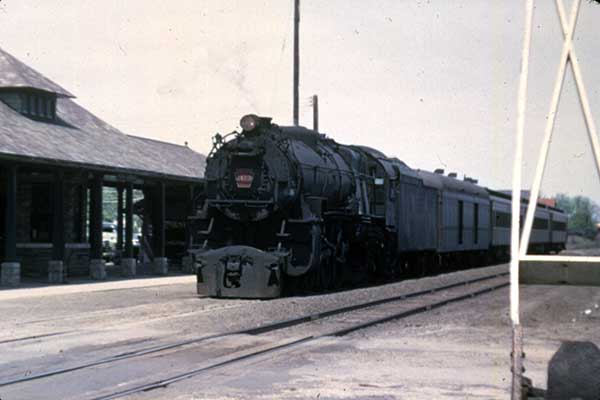
Above is PRR #1453 at the Point Pleasant Beach stop in the mid 1950s. I'm really itching to get moving on the layout, so hopefully I'll find a way to get things going again very soon. I also obtained some new motive power, which will be posted shortly on that page. Sorry everyone for the long vacuum of non-updates. (2/26/2023)
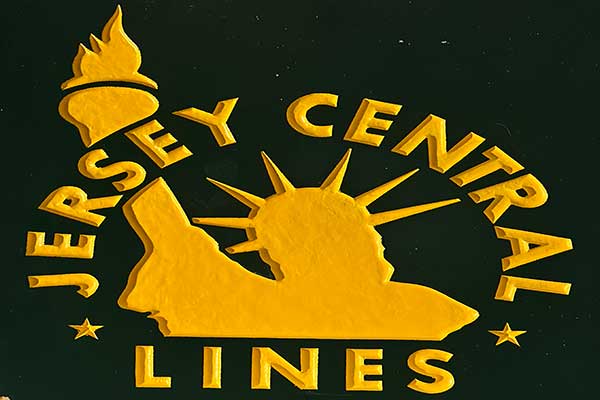
For those that might still be following my layout blog - I'm two months out from my retirement from the Postal Service. The past few working years have been brutal and I'm really looking forward to exiting my job. As for the layout, the storage I mentioned in previous posts has been removed for the most part, and a general cleaning up is ahead. (6/17/2024)
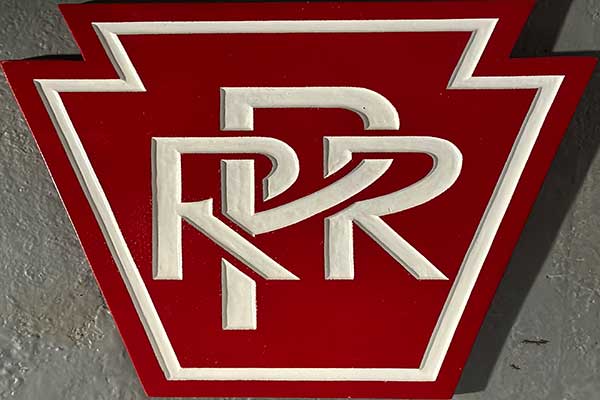
As much as work and various family obligations have
impeded work on the
layout, I've always had the layout on my mind. Over the next
few
months, I plan to get the basement back in working shape, and will be
implementing the final phase of the NY&LB. I have a
load of
catching up to do with the layout (and the basement where it resides)!
(6/27/2024)
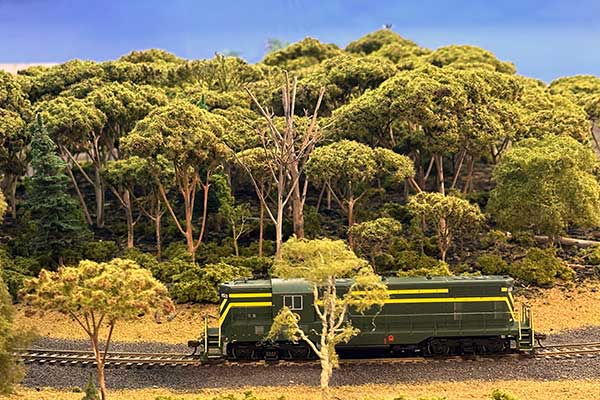
Yeah!!! I've joined the ranks of retired model railroaders! Right now I'm splitting my time between various hobbies/advocations and loving it! One of my last motive power purchases was this Athearn GP-7 shown going around my Bay Head Loop track on the layout. (10/20/2024)
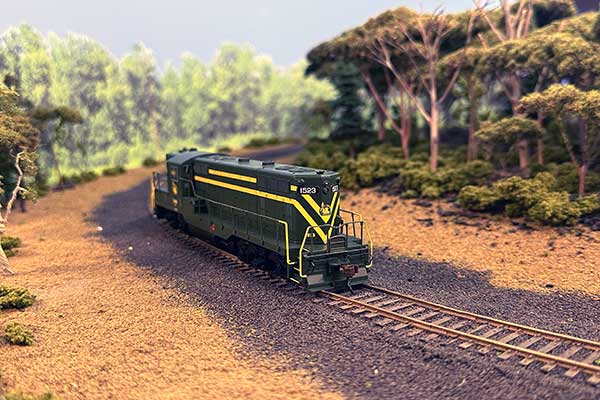
Here's another Photo I tood just this week. Cleanup of the basement is well under way and I'm looking forward to resuming work on the layout over the coming winter months. I know I've said this line many times before, but everything is much different for me now. (10/20/2024)